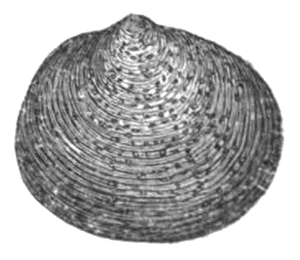Pea clams
| Pea clams | ||||||||||||
|---|---|---|---|---|---|---|---|---|---|---|---|---|

Pisidium punctiferum |
||||||||||||
| Systematics | ||||||||||||
|
||||||||||||
| Scientific name | ||||||||||||
| Pisidium | ||||||||||||
| Pfeiffer , 1821 |
The pea mussels ( Pisidium ) form a genus within the family of the spherical mussels (Sphaeriidae) from the class mussels (Bivalvia). They live in the sediment, the so-called benthal , of freshwater bodies of water. Due to the high variability of their shell and the lack of clear species characteristics, it is extremely difficult to identify individuals of the genus Pisidium at species level. The genus contains the smallest representatives of freshwater mussels.
Biological peculiarities of pea clams
In their anatomy they correspond to the basic structure of the mussels. Without a head or a rasping tongue ( radula ) they take their food as so-called filter feeders with the help of their gills from the surrounding water. Like the whales of the baleen whales , the gills serve as a filter structure for planktonic food particles. As a taxonomic group within the owl lamellar branchia, they have leaf gills, two pairs: an inner and an outer. With the help of these gills, the pea clams care for their brood. In contrast to the large mussels ( naiads ), they do not produce pelagic larvae and shelter their offspring in the protection of their shells.
Shell morphology
As with all mussels, the animal is wrapped in a two-lobed shell, which is held together at the vertebra, the umbo, by a lock strap, the ligament . A number of so-called teeth at the contact points of the two shells prevent mutual slipping by interlocking. The shape and position of these teeth are one of the most important determinants. In addition to two main or cardinal teeth, the curvature of the shell, the position of the vertebra and the structure of the shell (ribbed or not, with or without pores ... etc.) are used to determine the type. At their greatest extent, the shell of pea clams rarely reaches lengths of more than one centimeter. As a rule, only the pisidium amnicum becomes that large . Pisidium moitessierianum is only two millimeters long .
Spread of pea clams
Pea clams are found on all continents with the exception of Antarctica . Although the animals, like most mussels, only have a very limited active ability to spread, their passive ability to spread is considerable. Geographically, there are almost no barriers for them: in the plumage of birds, in the fur of mammals that are regularly in the water, pea clams can reach and colonize almost any suitable habitat . In the Alps, animals of this genus have been found at heights of up to 2600 meters (see Macun Lakes , Lower Engadine ). Their capacity to spread is limited less by geographical barriers such as mountain ranges, deserts or inlets than by their ecological demands on the habitat. There are rheophilic species that can only be found in springs and cosmopolitans such as Pisidium casertanum , who can colonize almost all freshwater habitats worldwide. One consequence of this enormous ability to spread is that there are only a few endemic species within this genus. So far, only two endemics are known within Europe: Pisidium edlaueri from Lake Ohrid and Pisidium maasseni from Lake Prespa .
Systematics
The systematics of pea mussels is currently being discussed anew in the specialist literature with the help of current molecular data. What is certain is that Pisidium is a paraphyletic group.
Sub-genera:
Species in Europe: (German common names according to Cole, 2016)
- Pisidium amnicum (OF Müller, 1774) ( large pea clam )
- Pisidium annandalei Prashad, 1925
- Pisidium casertanum (Poli, 1791) ( common pea clam )
- Pisidium conventus Clessin, 1877 ( sea pea shell )
- Pisidium edlaueri Kuiper, 1960
- Pisidium globulare Clessin, 1873 ( Marsh pea mussel ; is not listed as a separate species in the Fauna Europaea)
- Pisidium henslowanum (Sheppard, 1823) ( pea clam )
- Pisidium hibernicum Westerlund, 1894 ( Smooth pea clam )
- Pisidium hinzi Kuiper, 1975
- Pisidium lilljeborgii Clessin, 1886 ( circular pea shell )
- Pisidium maasseni Kuiper, 1987
- Pisidium milium Held, 1836 ( square pea clam )
- Pisidium moitessierianum Paladilhe, 1866 ( dwarf pea clam )
- Pisidium nitidum Jenyns, 1832 ( shiny pea clam )
- Pisidium obtusale ( Lamarck , 1818) ( puffed pea shell )
- Pisidium personatum Malm, 1855 ( spring pea mussel )
- Pisidium pseudosphaerium J. Favre, 1927 ( flat pea clam )
- Pisidium pulchellum Jenyns, 1832 ( beautiful pea clam )
- Pisidium subtruncatum Malm, 1855 ( crooked pea shell )
- Pisidium supinum A. Schmidt, 1851 ( triangular pea shell )
- Pisidium tenuilineatum Stelfox, 1918 ( smallest pea clam )
- Pisidium waldeni Kuiper, 1975
literature
- Ian J. Killeen, David Aldridge and Graham Oliver: Freshwater bivalves of Britain and Ireland. (Occasional publication Field Studies Council, 82). 114 pp., Field Studies Council, Shrewsbury 2004 ISBN 1-85153-892-5
Web links
Individual evidence
- ↑ Fauna Europaea. Retrieved December 18, 2018 .
- ↑ Th. CH Cole: Dictionary of Invertebrates / Dictionary of Invertebrates: Latin-German-English. Springer Spectrum, 2016, pp. 62–63 ISBN 978-3-662-52868-6 ( reading sample )
- ↑ ML Zettler & P. Glöer: On the ecology and morphology of the Sphaeriidae of the North German Plain. In: Heldia. Volume 6, special issue 8, 2006, pp. 1–61 ( digitized version )
